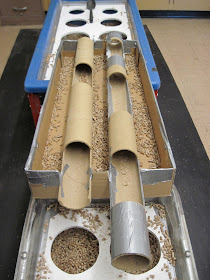Combining apparatus creates more complex and intriguing spaces for the children to explore. One of the reasons it is more complex and intriguing is that you are multiplying the number of dimensions and elements (in the right column of this blog) embodied in the new combination.
A little over a year ago, I wrote about combining apparatus here.
For the current combination of apparatus, I connected two sensory tables with cardboard tubes. This was an expansion of the TABLE COVERING WITH HOLES. Instead of one sensory table with the apparatus, I added another smaller table with the same apparatus.
Since the second table is smaller, I did not need the extra support that I needed for the bigger version of this apparatus. If you look at the post entitled TABLE COVERING WITH HOLES, you will see that the structure needed reinforcement underneath in the form of braces and legs because of the span it traversed from one end of the table to another. For this smaller table, all that was needed was a piece of 3/8 inch plywood with four holes. It was cut so it is wedged 2 inches down into the table with a six-inch space created under the apparatus to the bottom of the table.
With the two coverings in place, the two tables were then connected by cardboard tubes. It is important to note that in terms of dimensions, the tubes are oriented horizontally. With that orientation, the pellets do not slide down the tube, but must be moved through the tubes by operations the children devise.
There was an original design flaw which you do not see in this picture. What you see is the correction of that design flaw. Underneath the cardboard tubes is a box. That box is there to catch the pellets as they spill out of the tubes; without the box, the pellets spill onto the floor. The box did not change the fundamental operation of moving the pellets between the tables through the tubes. In fact, it offered the children another level and surface for play and exploration.
Before looking at how the children move the pellets in the tube, watch the following video to see again how a child uses the holes of the original apparatus. This two-year-old is scooping pellets with a large measuring cup. She has to adjust her scooping motions both to reach into a hole and to pull the cup out of the same hole. Watch how she monitors each time how many pellets she was able to retrieve.
That's impressive for a two-year-old. We should all monitor our work so well!
With the tubes, I added a homemade plunger of sorts. It is a cap from a jar that is attached with a screw onto a dowel. Since caps come in different sizes, it was not hard to find the size that fit nicely into the tubes.
The purpose of the plunger was to provide a tool the children could use to move the pellets through the tubes. Of course, children will always find their own uses for the tools provided. It also makes a great masher.
In the picture above, look at all the levels on which you can see pellets? This is a good illustration of how an apparatus creates multiple levels of play.
Now watch how one child uses the plunger to move the pellets through one of the tubes. Pay special attention to how many hindrances there are to moving the pellets through the tube and how many different solutions this child comes up with to surmount those hindrances.
This child uses the homemade plunger to push pellets through the tube. He starts on one end and reaches in with his hand to move the plunger to the first break in the tube. He grabs the head of the plunger to pull it through far enough so he can grab the handle. As he pushes the plunger, it won't go through the next hole. He slides his hand up the handle to push the head with a little more force. That doesn't work so he pulls the plunger out of the tube and orients the head so it is at an angle before pushing it into the tube. The repositioning of the head works so he is able to push the plunger into the hole and move the pellets up the tube. How did he come up with the solution? He pushes the plunger as far into the tube as he can. He then tries to grab the head of the plunger again to pull it through far enough to grab the handle. Notice, that is the same operation he used on the lower end of the tube. This time is does not work because the head of the plunger fits too tightly inside the tube. He takes his spoon and pushes the plunger handle so it moves out the the tube. He has just combined tools to complete his operation.
By combining apparatus, you can create new and interesting spaces for children to explore. In doing so, you will exponentially increase the amount and the variety of play originating from the children.






No comments:
Post a Comment